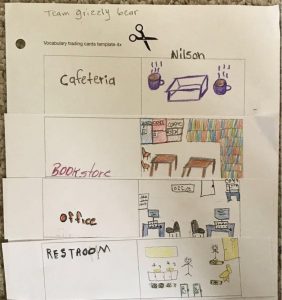5 Unit 5 Writing Fundamentals
“The difference between the almost right word and the right word is really a large matter. ’tis the difference between the lightning bug and the lightning.” – Mark Twain
Teacher to teacher:
Spelling is fundamental to good writers. I usually ban the use of smartphone dictionaries during class time. Too many students scroll through Facebook when they say they’re “checking” word meanings. I tell the students they are welcome to use phone dictionaries at home. In class, phones are a big distraction.
Beginner English students need to learn lots of words before they’re ready to write a sentence. You will see your beginners copying words into their notebooks with an imperfect grasp of meaning or pronunciation. Explicitly teach them the skills of vocabulary development.
First, introduce a list of vocabulary words. Drill the whole class in pronunciation, chorally and individually.
Second, do a couple of warmers to help the students use target words. Over the course of the class, they will receive plenty of word lists for their binders. You must invent ways to help the students remember their handouts are tools, not artifacts. These warmers can be “spelling fill in’s”, or a few sentences that include the vocabulary that you write on the class whiteboard.
Many students benefit from a memorization technique that uses eyes, ears and tongue. Speak the word aloud / Spell the word aloud, letter-by-letter while writing / Repeat speaking the word aloud.
Example: “living room” / l-i-v-i-n-g r-o-o-m / “living room”
Third, do group drawing activities. These activities are fun for the students, even though at first everyone claims to “be unable to draw.” I provide a template that allows a word to be written on one side, and a drawing done on the other. I draw an example for everyone to see. Once they witness my lack of artistic skills, everyone relaxes because they know their teacher will always be inferior to them. Each group of 3 or 4 students writes and draws their assigned words. I collect the original grids, photocopy the pages, and in the next class, distribute a complete set to everyone. I demonstrate how to use a pair of scissors and a single swipe of glue stick to create flash cards. I also provide a few plastic baggies for the students to store their cards. The interactive games you can invent using these flash cards are limitless.
Example: One student selects a flashcard and asks a partner student to mime the action to the class. As they guess the word being mimed, the class will be roaring with laughter in no time.
Finally, do a spelling test every few weeks. Speak each word twice. If the class is advanced, you can embed the target vocabulary word in a full sentence, and ask the students to listen for the word, and spell only that word. This is a challenging and wonderful way to extend your students’ listening comprehension skills.
When the test is over, collect the answer sheets and immediately redistribute them, each to a different student. Your students now get to “grade” a classmate’s spelling and add up a score. You will need to closely monitor this activity at first, because some students will mark spellings correct when they’re not. They may also not add up the results correctly. This activity is a great way to teach students to write English letters and numbers correctly.
After becoming accustomed to spelling vocabulary words, teach plurals, and incorporate them into their warm up sentences.
Best practices:
On occasion, I bring a print dictionary, like the Longman Dictionary of American English to class. Using the overhead projector, a “volunteer” practices finding a word on a page, understanding definitions, synonyms, and even using IPA pronunciation.
ELLs who want to write fluently soon learn the value of a good English/English dictionary. While it’s certainly possible to teach vocabulary using a free online version of this type of dictionary, I find the page-embedded advertisements for car insurance and constipation remedies totally obnoxious. The physical practice in checking the head word and end word on a page does develop the students’ understanding of alphabetization, and I find this exercise worthwhile.
It’s also useful for beginners to practice filling in administrative forms correctly. This teaches clear letter formation. Encourage students to save their cursive writing for personal note taking and love letters. Instead, everyone should print letters clearly.
Also. insist that everyone writes numbers without serifs and crossbars. [ 1, 7 ] and use a period, not a comma in decimals. By the end of the course, everyone should know firstname/lastname word order, American date format mm/dd/yy for birthdates, titles, e.g., Mr., Ms., and commonly used synonyms, e.g., “place of birth” = “country of origin”.
Additionally, you can create sentences that you cut apart into chunks and ask the class to assemble in correct order. This is a wonderful way for students to learn that English is modular, that verbs and ending punctuation can’t be left out, and that often the writer can reorder the chunks to vary their writing. If there’s time, I will teach adverbs of frequency (always, sometimes, often, never,…) This interactive cut ‘n’ paste activity is a particularly good technique to use.
Level 1 English learners should focus exclusively on constructing simple present tense sentences in S-V-O word order. Once they have mastered this skill, they are well on their way to internalizing the fundamental techniques of clear sentence construction.
Unit 5 Writing fundamentals
Vocab Trading Cards Template 4X PDF
Vocab Trading Cards Template 10X PDF

Example of student-created vocabulary flash cards, before you give them scissors and a glue stick.

